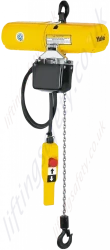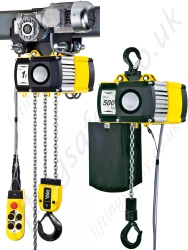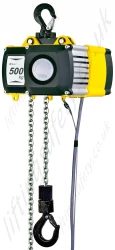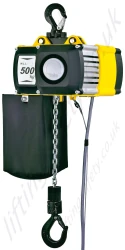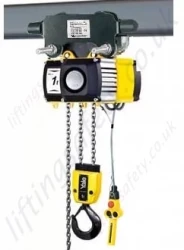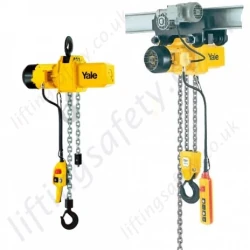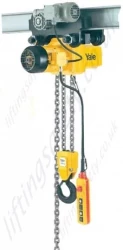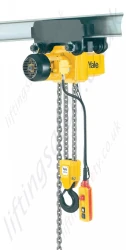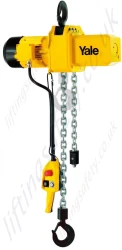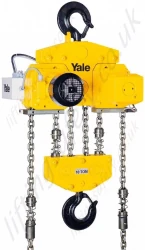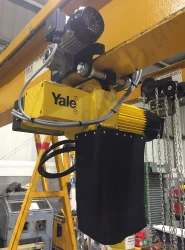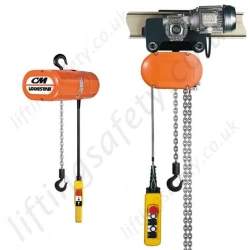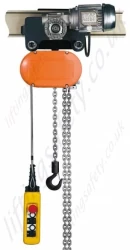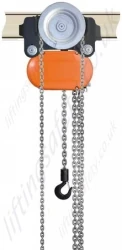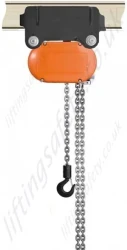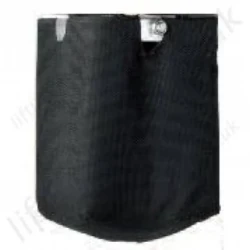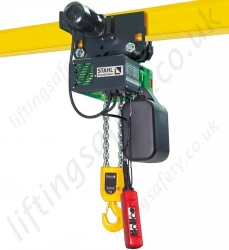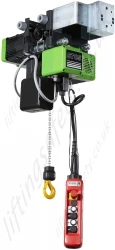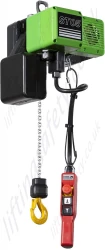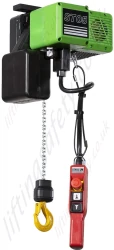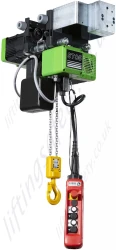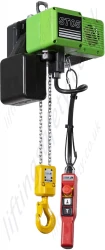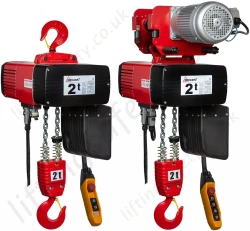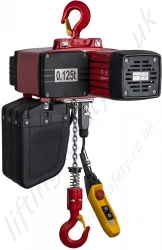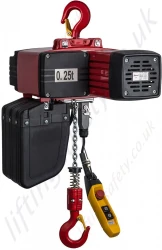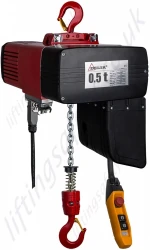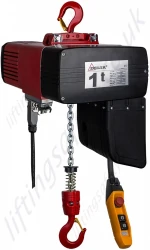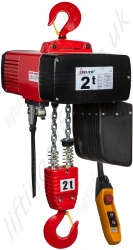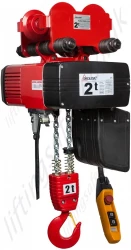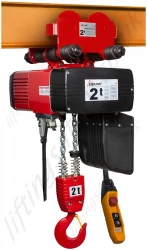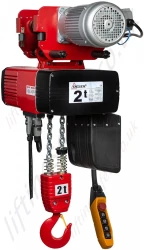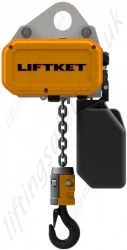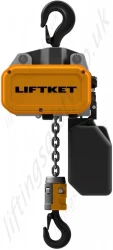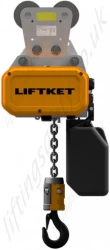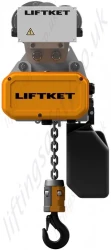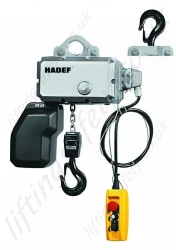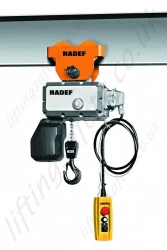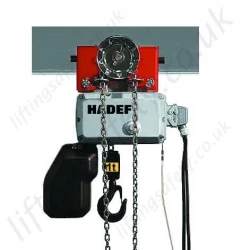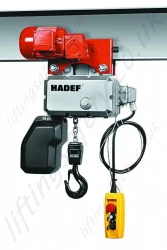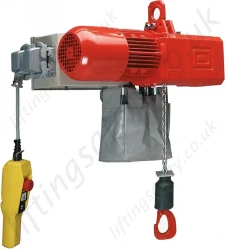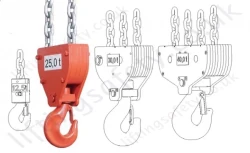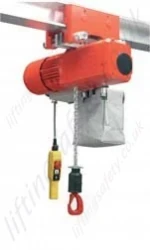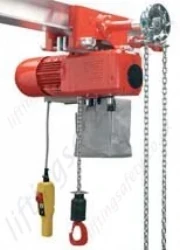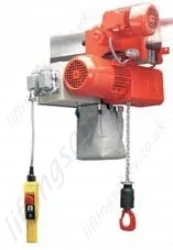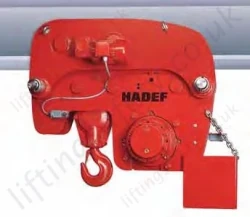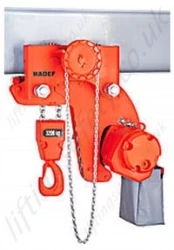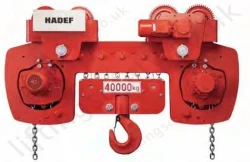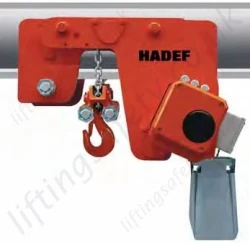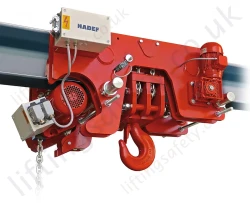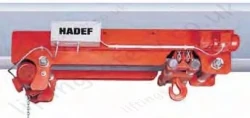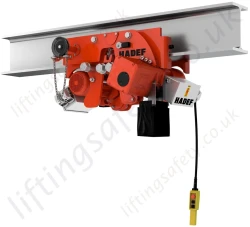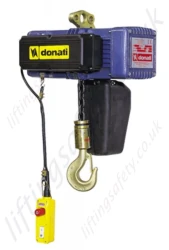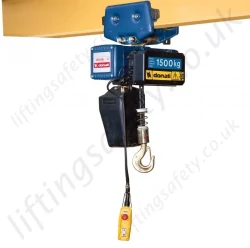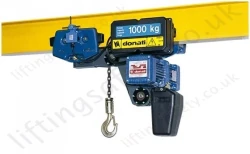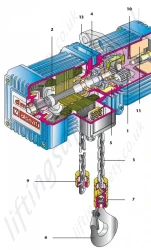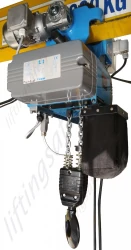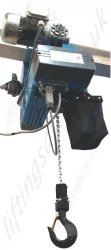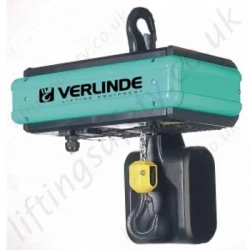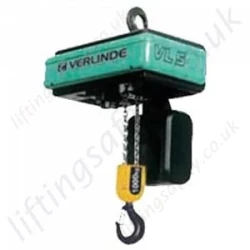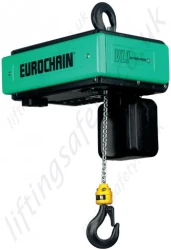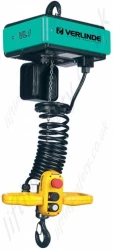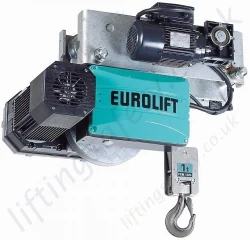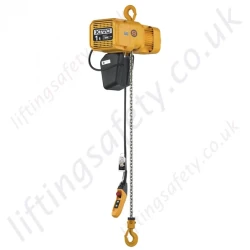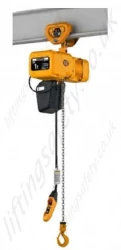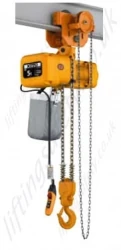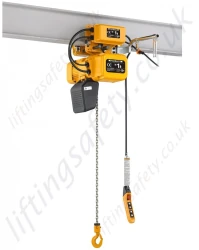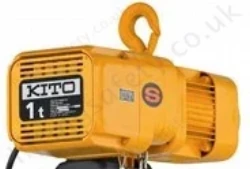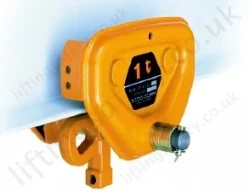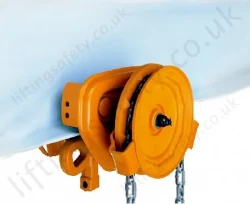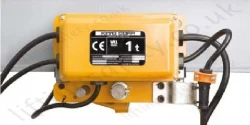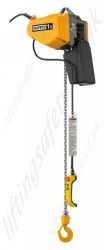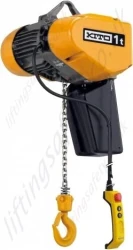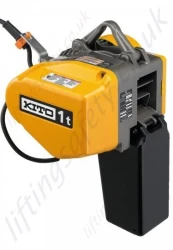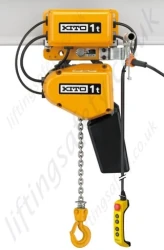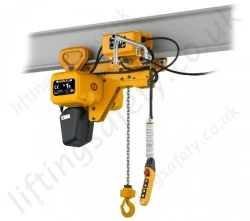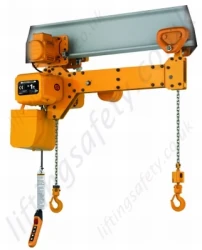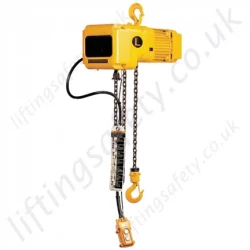400V/415V Electric Hoists
By far, the greater majority of electric hoists available within the industrial marketplace are 400V or 415V. This is primarily because better duty cycles are possible with a 400/415-volt 3-phase power supply than with a 110V or 230V single-phase supply.
Below, you can browse the vast range of standard and in some instances, more unique 400/415V electric hoist models that we offer, that operate on a 3-phase 50Hz power supply. But, we do also offer hoists to suit alternative voltages, so please do not hesitate to get in touch if you require a unit suitable for more specialist voltages, for example, 690V on a wind turbine, on a 415V 3Ph 60Hz supply, or another voltage that's not mentioned here.
Standard 110V hoist and 230V hoist ranges are also available from Lifting Safety, as well as battery-powered hoists; however, there are more limitations to the options and capacities available, so sadly, there is less choice on single-phase electric hoists.
Yale CPS Lightweight Electric Chain Hoist
Yale's light-duty 125kg or 250kg top hook suspension electric hoist in 110v, 230v or 400v.
Model: Yale CPS / LCH1-1003
A small and light weight (only 12kg when 3m HOL) Industrial quality electric chain hoist. Electrical protection to IP54 as standard with low voltage pendant control and overload protection. Smooth operation. Thermally protected hoist duty motor with dual braking system and rugged cast aluminium alloy hoist frame, 5:1 factor of safety yet small, compact design for industrial applications. Hardened forged steel latch-style lower hook rotates 360°.
Yale CPV Electric Chain Hoist
Yale's medium-duty 400v or 230v electric hoist, available in capacities from 250kg upto 5 tonne WLL with options for hook/lug suspension or manual/electric beam trolleys.
Model: CPV / CPVF / YCEC-4989
Capacity options available are: 250kg, 500kg, 1000kg (1 tonne), 2000kg (2 tonne), 2500kg (2.5 tonne) and 5000kg (5 tonne).
Yale CPV 400v Electric Hoist, Hook or Lug Suspended
Yale's medium-duty 3ph 50Hz electric chain hoist with top hook or eye suspension, available in capacities from 250kg upto 5 tonne WLL. 230V/1ph/50Hz is also on offer.
Model: Yale CPV / YCEC-5566
Capacity options available are: 250kg, 500kg, 1000kg (1 tonne), 2000kg (2 tonne), 2500kg (2.5 tonne) and 5000kg (5 tonne).
Yale CPV 400v Electric Hoist with Push Beam Trolley
Yale's medium-duty 3-phase 50Hz electric chain hoist with manual push/pull beam trolley, available in capacities from 250kg upto 5 tonne WLL. Single-phase, 230 volt is also available.
Model: Yale CPV / YCEC-5567
Capacity options available are: 250kg, 500kg, 1000kg (1 tonne), 2000kg (2 tonne), 2500kg (2.5 tonne) and 5000kg (5 tonne).
Yale CPV 400v Electric Hoist with Electric Beam Trolley
Yale's medium-duty 3-phase 50Hz electric chain hoist with electric powered beam trolley, available in capacities from 250kg upto 5 tonne WLL. Also available as 230V single-phase
Model: Yale CPV / YCEC-5568
Capacity options available are: 250kg, 500kg, 1000kg (1 tonne), 2000kg (2 tonne), 2500kg (2.5 tonne) and 5000kg (5 tonne).
Yale CPE 400v Electric Chain Hoist
Yale's heavy-duty 3ph electric hoist available from 1.6 tonne to 10 tonne WLL with options for hook or beam trolley suspension. The more robust option to the CPV.
Model: Yale CPE/CPEF / EH3-235
Capacity options available are: 1600kg (1.6 tonne), 2000kg (2 tonne), 2500kg (2.5 tonne), 3000kg (3 tonne), 3200kg (3.2 tonne), 4000kg (4 tonne), 5000kg (5 tonne), 7500kg (7.5 tonne) and 10000kg (10 tonne).
All CPE electric hoists can be offered with a single lifting speed or dual speed lifting (CPEF being dual speed).
All models are available with a top hook suspension point, or with a built-in, directly connected (no top hook) beam trolley that can be supplied as a manual push-pull trolley, a geared travel (hand chain driven) or electric beam trolley, which is also available with single or dual speed travel.
CM Lodestar Electric Chain Hoist
Heavy-duty 110v, 230v 1ph or 400v 3ph electric hoist built for the hire industry in capacities starting from 250kg up to 3 tonne.
Model: CM Lodestar / ECH1-243
CMLS Single or Three Phase Hoist is a top quality electric chain hoist renowned the world over. The Lodestar is a tough, durable electric chain hoist, designed to keep working in the most arduous conditions. Features include 50% duty rating (30 minutes continuous use per hour). Overload protection and heights of lift up to 60 metres are available.
Capacity available: 250kg, 500kg, 1000kg, 2000kg and 3000kg with hook suspension or with manual trolley or electric power travel trolley.
Stahl ST Electric Chain Hoist
400v 3ph 50hz electric hoists with a wide variety of options such as extra low headroom and atex certification, in capacities from 125kg up to 5 tonne.
Model: Stahl ST / SSEH-4522
The ST series from STAHL CraneSystems is available in 9 load capacity variants for the load capacity range from 125kg to 5,000kg. The chain hoists can be used as stationary models with suspension hook or eye, with rigid suspension or with a push trolley. Or when completed by an electric trolley they are mounted on standard cranes, off-standard cranes or in systems manufacture.
Delta DEH Electric Chain Hoist
400v 3ph 50hz electric hoist with options for hook, lug or trolley suspension and an optional radio remote. 125kg to 5000kg Capacity
Model: Delta DEH / DECH-5487
Liftket Star Speedline Electric Chain Hoist
400v 3ph electric hoist with capacity options from 125kg up to 5 tonne. Various suspension options. Manufactured in Germany.
Model: STAR Speedline / LSEC-5203
Capacity options available: 125kg, 250kg, 500kg, 1000kg, 1600kg, 2000kg, 2500kg, 3200kg & 5000kg
Suspension types: Single eye, fixed hook (non-rotating), twin eye (for fitting specifically to Liftket beam trolleys), manual push/pull beam trolley or electric beam trolley.
Hadef 62/05S Hook/Eye Suspended Electric Chain Hoist
Easy to use, compact and lightweight electric hoist in capacities from 125kg upto 2 tonne.
Model: 62/05S / HPEC-4397
Request QuoteHadef 62/05R Electric Chain Hoist with Push Beam Trolley
Easy to use, compact and lightweight electric hoist with integrated push travel trolley, available from 125kg to 2 tonne.
Model: 62/05R / HPEC-4398
Request QuoteHadef 62/05H Electric Chain Hoist with Geared Beam Trolley
Easy to use, compact and lightweight electric hoist with built-in geared travel trolley, available from 125kg to 2 tonne.
Model: 62/05H / HPEC-4399
Request QuoteHadef 62/05E Electric Chain Hoist with Electric Beam Trolley
Easy to use, compact and lightweight electric hoist with built-in electric powered travel trolley, available from 125kg to 2 tonne.
Model: 62/05E / HPEC-4400
Request QuoteHadef 66/04 AKS Electric Chain Hoist with Eye Suspension
Compact design electric hoist with overload protection built-in as standard. Atex option available. 250kg to 30 tonne.
Model: 66/04 AKS / HAPE-4318
Request QuoteIP 55 Enclosure / optional IP 66, Mechanic hoist protection by current cut-off (AKS 4-8)
Zinc plated high quality RUD load chain.
Atex Certification Available.
Hadef 66/04 AKR Electric Chain Hoist with Push Beam Trolley
Compact design electric hoist with built in manual push travel trolley. Overload Protection included as standard. Atex Option Available. Capacity range from 250kg to 30 tonne.
Model: AKR / HAPE-4320
Request QuoteHadef 66/04 AKH Electric Chain Hoist with Geared Beam Trolley
Compact design electric hoist with built in geared travel trolley, available from 250kg to 30-tonne. Overload protection included as standard. Atex option available.
Model: AKH / HAPE-4322
Request QuoteIP 55 Enclosure / optional IP 66, Mechanic hoist protection by current cut-off (AKH 4-8)
Zinc plated high quality RUD load chain.
Atex Certification Available.
Comes as standard with Geared Travel Trolley.
Hadef 66/04 AKE Electric Chain Hoist with Electric Beam Trolley
Compact design electric hoist with built in electric powered (motorised) travel trolley, available from 250kg to 30-tonne. Overload protection included as standard. Atex option available
Model: 66/04 AKE / HAPE-4323
Request QuoteIP 55 Enclosure / optional IP 66, Mechanic hoist protection by current cut-off (AKH 4-8)
Zinc plated high quality RUD load chain.
Atex Certification Available.
Comes as standard with Electric (motorised) Travel Trolley.
Hadef 28/06 ER Low Headroom Electric Chain Hoist with Push Beam Trolley
Premium low profile monorail electric hoist with integral push travel trolley, available from 0.5 tonne to 3.2 tonne.
Model: 28/06 ER / HEPL-4324
Request QuoteHadef 28/06 EH Low Headroom Electric Chain Hoist with Geared Beam Trolley
Premium low profile monorail electric hoist with integral geared travel trolley, available from 0.5 tonne to 40 tonne.
Model: 28/06 EH / HEPL-4326
Request QuoteHadef 28/06 EE Low Headroom Electric Chain Hoist with Electric Beam Trolley
Premium low profile electric hoist with integrated electric powered travel (motorised) monorail trolley, available from 0.5t to 40t.
Model: 28/06 EE / HEPL-4325
Request QuoteHadef 29/06 UL-EH Ultra Low Headroom Electric Chain Hoist with Geared Beam Trolley
Premium ultra low-profile electric hoist combined with an integrated geared travel monorail trolley, available from 1 tonne to 40 tonne.
Model: UL-EH / HUPU-4327
Request QuoteHadef 29/06 UL-EE Ultra Low Headroom Electric Chain Hoist with Electric Beam Trolley
Premium ultra low-profile electric hoist combined with an electric powered travel (motorised) monorail trolley, from 1 tonne to 50 tonne.
Model: 29/06 UL-EE / HUPU-4328
Request QuoteHadef 28/06 EEL Big Bag Ultra Low Headroom Electric Chain Hoist with Electric Beam Trolley
Very low profile electric hoist with powered travel (motorised) trolley, available from 1t to 6.3t with optimal horizontal width between hook and hoist unit, specifically designed for handling 'big bags'.
Model: 28/06 EEL Big-Bag / HEBU-4329
Request QuoteThe Hadef EEL Big-Bag Electric Chain hoists allow for maximum lift where minimum headroom is required, the horizontal width between the hook and the hoisting unit is entirely optimal and can be tailored to suit your needs.
Hadef 29/06 EHS-Syncro Ultra Low Headroom Electric Chain Hoist with Geared Beam Trolley
Very low profile electric hoist for restricted headroom applications, with built-in geared travel trolley, available from 500kg to 3.2t. Two drives for smooth lifting/lowering with high lifting speeds
Model: HEUL-4330
Request QuoteHadef 29/06 EES-Syncro Ultra Low Headroom Electric Chain Hoist with Electric Beam Trolley
Very low profile electric hoist for restricted headroom applications, from 0.5t to 3.2t, with built-in electric powered (motorised) trolley. Two drives for smooth lifting/lowering with high lifting speeds.
Model: 29/06 EES / HEUL-4331
Request QuoteDonati DMK Electric Chain Hoist
400v 3Ph 50Hz electric hoist with options for hook/eye suspension or manual, geared and electric trolleys. Single or dual speed lift/travel. 125kg to 4 tonne.
Model: DMK / DDEC-4296
Request QuoteThe DMK series electric chain hoists can be used in fixed execution (hook or eye) with hand-pushed trolley, electric trolley, trolley in low headroom configuration also in climbing execution. The high quality of Donati products is guaranteed by a Quality System Certificate UNI EN ISO 9001:2000.
GIS Food Grade Electric Chain Hoist
250kg to 1250kg 3 phase food grade / pharmaceutical environment electric chain hoist. Lug or top hook suspended.
Model: GIS GKM / GEFG-4406
Request QuoteTractel Volt-Trac Electric Chain Hoist
400v 3ph 50Hz, 250kg to 2000kg electric hoist with various suspension options including hook, eye, manual trolley or electric powered trolley.
Model: VoltTrac / TVEH-5114
Request QuoteVerlinde VLA Wind Turbine Electric Chain Hoist
High-speed electric hoists suitable for use with power supply's up to 690v for use on wind turbines. 160kg to 1 tonne.
Model: WTCH-2626
Request QuoteOptions on Wind Turbine Chain Hoist: Safe working load, trolley required, height of lift is 16 to 80 metres.
Wide range of lifting speeds:16 and 4 m/min, 24 & 6 m/min and 32 & 8 m/min, upper and lower electric limit switches
Brake clutch system: DC electromagnetic disk brake made to last as long as the hoist itself.
Hook: Upper hook (detachable) and lower hook complies with DIN standard, Motor: Thermal protection
Verlinde Eurochain VL 400v Electric Chain Hoist
Three phase (3ph 50Hz) electric hoist with various suspension options and available from 60kg to 10 tonne capacity.
Model: 3ECH-2437
Request QuoteThe 3 phase standard electric chain hoist, height of lift 3m as standard. The Eurochain VL has 2 hoisting speeds and upper and lower electric limit switch. Paint 5 years guaranteed.
Comes in various ranges: Fixed hook suspension, push travel trolley, geared travel trolley and variable speed electric travel.
Verlinde Eurochain VL INOX 400v Electric Chain Hoist
Three phase (3ph 50Hz) electric hoist with stainless load chain and various suspension options. Available from 60kg capacity.
Model: HSH-742
Request QuoteThis hook suspended hoist with height of lift 3m as standard, 2 hoisting speeds with upper and lower electric limit switch, torque limiter and chain collector.
Various options available: hook suspended, push travel trolley and electric travel trolley.
Verlinde VL Variable Speed Electric Chain Hoist
3 phase variable lifting speed stepless electric hoist in capacities from 0.5 to 7.5 tonne.
Model: SCH-834
Request QuoteThe variable lifting speed stepless chain hoist is available with hook suspension, push travel trolley, geared travel or electric travel trolley.
Power supply 380 to 480V / 3PH / 50Hz 60Hz and low voltage control 48V (115 or 230 as option). Variable travelling speed on electric trolley (except 3 falls hoist). Motor thermal protection, Electric limit switch, Torque limiter
Available in sizes ranging from 500kg to 7500kg on request.
Verlinde Eurochain VL Digichain Electric Chain Hoist with Positioner Hook
3 phase electric hoist with hook controls. 60kg to 500kg capacity.
Model: PHH-746
Request QuoteThe electric chain hoist EUROCHAIN VL DIGICHAIN includes same equipment as standard model except: maximum height of lift 3m, hand tight positioner on push button type DIGICHAIN with 3m control cable, upper and lower electric limit switches, moveable lifting hook, low voltage control 48V on hand tight positioner with push button
Options on positioner hook hoist: Safe working load, hoist speed, suspension type.
Available in sizes 60kg, 125kg, 250kg and 500kg.
Verlinde Eurolift BH Low Headroom Belt Hoist
3 phase low headroom belt hoist for food industry. 500kg to 2 tonne.
Model: LHBH-751
Request QuoteOptions on Low Headroom Belt Hoist: Safe working load, HOL (Height of lift) (m), suspension type.
Very low headroom, true vertical lift. The EUROLIFT BH is specially designed for the food industry. Standard features included in basic prices: Power supply 400V / 3Ph / 50Hz, trolley with stepless speeds 5 > 20 m/min, overload limiter (110% of max. load), upper and lower limit switch, thermal protection, electrically isolated hook block and push button box.
Kito ER2 Heavy Duty Electric Chain Hoist
400v 3 phase electric hoist with fast lifting speeds. Capacity options from 125kg to 15 tonne.
Model: ER2 / KSHS-4188
Request QuoteThe New Kito "ER2 Series" Electric Chain Hoist further builds upon Kito's previous ER Series, seeking improved ease of use and superb working efficiency. To ensure safety, The hoist utilises a "double safety" mechanism that consists of a unique Friction Clutch and Upper-Lower limit switch. The control system features a fresh push-button interface and can easily be used for hours on end.
Various Options for this product are available in the form of: Hook Suspended, Push Travel Trolley, Geared Travel Trolley, Motorised Trolley, Multiple Lifting Speeds, Multiple Traversing Speeds
Kito EQ Normal Duty Electric Chain Hoist
Lightweight 125kg to 1000kg electric hoist with inverter, overload limiter and corrosion resistant load chain.
Model: EQ Series / KSCR-4187
Request QuoteThe Kito "EQ Series" Electric Chain Hoist is equipped with an Inverter which can change the control between mechanical and electrical, whilst keeping its conventional rigidity and high functions.
In addition to the safety functions such as the Overload Limiter, Friction Clutch and Upper-Lower limit switch, Push Buttons have been redesigned to allow prolonged use with ease.
Kito SHER2 Low Headroom Electric Chain Hoist
Ultra-low profile electric chain hoist with capacity options from 250kg to 5 tonne.
Model: Kito SHER2 / LHH-1150
Request QuoteKito TWER2 Twin Hook Electric Chain Hoist
Double hook electric chain hoist with hook suspension or electric travelling beam trolley. 250kg to 5 tonne.
Model: TWER / TWERM / THH-1151
Request QuoteKito SNER Extreme Duty Electric Chain Hoist
Heavy-duty rated electric hoist, a revolutionary 220v unmatched single phase hoist. 250kg to 3 tonne.
Model: Kito SNER / EDEC-3095
Request QuoteThe Kito SNER electric chain hoists are built for extreme duty applications which require a single phase power supply. Maintenance friendly features include a unique chain guide, hinged control panel, sealed housing and durable load sheave.
Options available: Custom lift lengths to suit your requirements, chain bag to keep chain clean and out of the way, plain or geared trolley mount for improved load control.
Kito ER Single Speed Electric Chain Hoist
Heavy-duty 3 phase electric hoist with single speed lifting. 250kg to 5 tonne.
Model: KITO ER / KEH-1142
Request QuoteOptions on Kito Electric Hoist: Model, Additional Height of Lift per Metre (3mtr as Std).
Yale's light-duty 125kg or 250kg top hook suspension electric hoist in 110v, 230v or 400v.
Yale's medium-duty 400v or 230v electric hoist, available in capacities from 250kg upto 5 tonne WLL with options for hook/lug suspension or manual/electric beam trolleys.
Yale's medium-duty 3ph 50Hz electric chain hoist with top hook or eye suspension, available in capacities from 250kg upto 5 tonne WLL. 230V/1ph/50Hz is also on offer.
Yale's medium-duty 3-phase 50Hz electric chain hoist with manual push/pull beam trolley, available in capacities from 250kg upto 5 tonne WLL. Single-phase, 230 volt is also available.
Yale's medium-duty 3-phase 50Hz electric chain hoist with electric powered beam trolley, available in capacities from 250kg upto 5 tonne WLL. Also available as 230V single-phase
Yale's heavy-duty 3ph electric hoist available from 1.6 tonne to 10 tonne WLL with options for hook or beam trolley suspension. The more robust option to the CPV.
Heavy-duty 110v, 230v 1ph or 400v 3ph electric hoist built for the hire industry in capacities starting from 250kg up to 3 tonne.
400v 3ph 50hz electric hoists with a wide variety of options such as extra low headroom and atex certification, in capacities from 125kg up to 5 tonne.
400v 3ph 50hz electric hoist with options for hook, lug or trolley suspension and an optional radio remote. 125kg to 5000kg Capacity
400v 3ph electric hoist with capacity options from 125kg up to 5 tonne. Various suspension options. Manufactured in Germany.
Easy to use, compact and lightweight electric hoist in capacities from 125kg upto 2 tonne.
Easy to use, compact and lightweight electric hoist with integrated push travel trolley, available from 125kg to 2 tonne.
Easy to use, compact and lightweight electric hoist with built-in geared travel trolley, available from 125kg to 2 tonne.
Easy to use, compact and lightweight electric hoist with built-in electric powered travel trolley, available from 125kg to 2 tonne.
Compact design electric hoist with overload protection built-in as standard. Atex option available. 250kg to 30 tonne.
Compact design electric hoist with built in manual push travel trolley. Overload Protection included as standard. Atex Option Available. Capacity range from 250kg to 30 tonne.
Compact design electric hoist with built in geared travel trolley, available from 250kg to 30-tonne. Overload protection included as standard. Atex option available.
Compact design electric hoist with built in electric powered (motorised) travel trolley, available from 250kg to 30-tonne. Overload protection included as standard. Atex option available
Premium low profile monorail electric hoist with integral push travel trolley, available from 0.5 tonne to 3.2 tonne.
Premium low profile monorail electric hoist with integral geared travel trolley, available from 0.5 tonne to 40 tonne.
Premium low profile electric hoist with integrated electric powered travel (motorised) monorail trolley, available from 0.5t to 40t.
Premium ultra low-profile electric hoist combined with an integrated geared travel monorail trolley, available from 1 tonne to 40 tonne.
Premium ultra low-profile electric hoist combined with an electric powered travel (motorised) monorail trolley, from 1 tonne to 50 tonne.
Very low profile electric hoist with powered travel (motorised) trolley, available from 1t to 6.3t with optimal horizontal width between hook and hoist unit, specifically designed for handling 'big bags'.
Very low profile electric hoist for restricted headroom applications, with built-in geared travel trolley, available from 500kg to 3.2t. Two drives for smooth lifting/lowering with high lifting speeds
Very low profile electric hoist for restricted headroom applications, from 0.5t to 3.2t, with built-in electric powered (motorised) trolley. Two drives for smooth lifting/lowering with high lifting speeds.
400v 3Ph 50Hz electric hoist with options for hook/eye suspension or manual, geared and electric trolleys. Single or dual speed lift/travel. 125kg to 4 tonne.
250kg to 1250kg 3 phase food grade / pharmaceutical environment electric chain hoist. Lug or top hook suspended.
400v 3ph 50Hz, 250kg to 2000kg electric hoist with various suspension options including hook, eye, manual trolley or electric powered trolley.
High-speed electric hoists suitable for use with power supply's up to 690v for use on wind turbines. 160kg to 1 tonne.
Three phase (3ph 50Hz) electric hoist with various suspension options and available from 60kg to 10 tonne capacity.
Three phase (3ph 50Hz) electric hoist with stainless load chain and various suspension options. Available from 60kg capacity.
3 phase variable lifting speed stepless electric hoist in capacities from 0.5 to 7.5 tonne.
3 phase electric hoist with hook controls. 60kg to 500kg capacity.
3 phase low headroom belt hoist for food industry. 500kg to 2 tonne.
400v 3 phase electric hoist with fast lifting speeds. Capacity options from 125kg to 15 tonne.
Lightweight 125kg to 1000kg electric hoist with inverter, overload limiter and corrosion resistant load chain.
Ultra-low profile electric chain hoist with capacity options from 250kg to 5 tonne.
Double hook electric chain hoist with hook suspension or electric travelling beam trolley. 250kg to 5 tonne.
Heavy-duty rated electric hoist, a revolutionary 220v unmatched single phase hoist. 250kg to 3 tonne.
Heavy-duty 3 phase electric hoist with single speed lifting. 250kg to 5 tonne.
Why would you choose a 415V electric hoist over a 110V or 230V electric hoist?
Choosing between a 400V/415V (3-phase) and a single-phase 110V or 230V (single-phase) electric hoist comes down to power requirements, usage conditions, and application demands. Here’s why you might choose a 400V/415V hoist over a 110V or 230V one:
Reasons to Choose a 400V/415V (Three-Phase) Hoist
-
More Power for Heavier Loads
-
400V / 415V hoists are typically used for heavier lifting capacities (e.g. 1 tonne and above). Most 400V 3-phase 50Hz electric hoists will run on a 415V 3-phase 50Hz power supply and vice versa, but it's always worth confirming this for a particular hoist, because this may not be the case in some instances.
-
They deliver smoother, more consistent power, making them ideal for industrial applications.
-
-
Better Duty Cycle & Frequent Operation
-
400V / 415V motors can operate for longer periods without overheating.
-
Ideal for frequent or continuous lifting - less downtime, better efficiency.
-
-
Increased Efficiency
-
3-phase motors are generally more energy efficient and have lower power losses.
-
Over time, this results in reduced operating costs.
-
-
Smoother Operation
-
They have better torque characteristics, meaning less stress on mechanical components, smoother starts/stops, and less wear over time.
-
-
More Reliable in Industrial Environments
-
In commercial and industrial settings where 3-phase power is standard, 415V hoists integrate easily and are built for tougher use.
-
When a 400V/415V Hoist May NOT Be Suitable
-
If your location only has single-phase power (110V or 230V) - common in residential or light commercial buildings - a 400V/415V hoist would not be usable without a phase converter.
-
If you're only lifting light loads occasionally, a 110V or 230V hoist may be more cost-effective and easier to install.
Summary Table
| Feature | 400V / 415V Hoist | 110V / 230V Hoist |
|---|---|---|
| Power Supply | 3-phase, 50Hz | Single-phase, 50Hz |
| Lifting Capacity | Higher (125kg up to 100 tonnes) | Lower to medium (60kg up to 3 tonnes) |
| Duty Cycle | Longer/heavy-duty | Shorter/light-duty |
| Efficiency | More efficient | Less efficient |
| Installation | Needs a 3-phase supply | Needs a 110V or 230/240V 1-phase supply |
| Cost (initial) | Higher | Lower |
| Maintenance | Typically more robust | Simpler, but may wear faster |
Bottom line:
Choose a 400V or 415V hoist if you're in an industrial setting, lifting heavy loads regularly and need reliable, long-term performance. Use a 110V or 230V hoist for lighter, occasional tasks in locations without 3-phase power.


